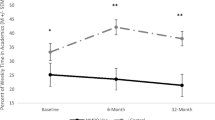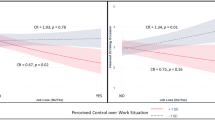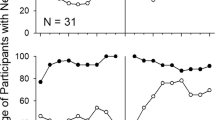Abstract
Drug addiction is a chronic, relapsing health problem that is associated with the degree to which individuals choose small, immediate monetary outcomes over larger, delayed outcomes. This study was a secondary analysis exploring the relation between financial choices and drug use in opioid-dependent adults in a therapeutic workplace intervention. Sixty-seven participants were randomly assigned to a condition in which access to paid job training was contingent upon naltrexone adherence (N = 35) or independent of naltrexone adherence (N = 32). Participants could earn approximately $10 per hour for 4 hours every weekday and could exchange earnings for gift cards or bill payments each weekday. Urine was collected and tested for opiates and cocaine thrice weekly. Participants’ earning, spending, and drug use were not related to measures of delay discounting obtained prior to the intervention. When financial choices were categorized based on drug use during the intervention, however, those with less frequent drug use or frequent use of one drug spent a smaller proportion of their daily earnings and maintained a higher daily balance than those who frequently tested positive for both drugs (i.e., opiates and cocaine). Several patterns described the relation between cumulative earning and spending including no saving, periods of saving, and sustained saving. One destructive effect of drug use may be that it creates a perpetual zero-balance situation in the lives of users, which in turn prevents them from gaining materials that could help to break the cycle of addiction.





Similar content being viewed by others
References
Beck, A. T., Steer, R. A., & Brown, G. K. (1996). Manual for Beck Depression Inventory-II (BDI-II). San Antonio: Psychology Corporation.
Bickel, W. K., & Marsch, L. A. (2001). Toward a behavioral economic understanding of drug dependence: delay discounting processes. Addiction, 96(1), 73–86. doi:10.1046/j.1360-0443.2001.961736.x.
Bickel, W. K., Odum, A. L., & Madden, G. J. (1999). Impulsivity and cigarette smoking: delay discounting in current, never, and ex-smokers. Psychopharmacology, 146, 447–454.
Black, A. C., & Rosen, M. I. (2011). A money management-based substance use treatment increases valuation of future rewards. Addictive Behaviors, 36(1), 125–128. doi:10.1016/j.addbeh.2010.08.014.
Carroll, M. E., Anker, J. J., Mach, J. L., Newman, J. L., & Perry, J. L. (2010). Delay discounting as a predictor of drug abuse. In G. J. Madden & W. K. Bickel (Eds.), Impulsivity: The behavioral and neurological science of discounting (pp. 243–271). Washington, DC: American Psychological Association.
Chabris, C. F., Laibson, D., Morris, C. L., Schuldt, J. P., & Taubinsky, D. (2008). Individual laboratory-measured discount rates predict field behavior. Journal of Risk and Uncertainty, 37(2/3), 237–269. doi:10.1007/s11166-008-9053-x.
Cottler, L. B. (1991). The CIDI and CIDI-substance abuse module (SAM): Cross-cultural instruments for assessing DSM-III, DSM-III-R, and ICD-10 criteria. In L. S. Harris (Ed.), Proceedings of the Committee on Problems of Drug Dependence 1990 (NIDA Research Monograph 105, DHHS Pub. No. ADM 91-1754 (pp. 167–177). Rockville: Department of Health and Human Services.
Dunn, K. E., Defulio, A., Everly, J. J., Donlin, W. D., Aklin, W. M., Nuzzo, P. A., & Silverman, K. (2013). Employment-based reinforcement of adherence to oral naltrexone treatment in unemployed injection drug users. Experimental and Clinical Psychopharmacology, 21(1), 74–83. doi:10.1037/a0030743.
Hamilton, K. R., & Potenza, M. N. (2012). Relations among delay discounting, addictions, and money mismanagement: implications and future directions. The American Journal of Drug and Alcohol Abuse, 38(1), 30–42. doi:10.3109/00952990.2011.643978.
Heil, S. H., Johnson, M. W., Higgins, S. T., & Bickel, W. K. (2006). Delay discounting in currently using and currently abstinent cocaine-dependent outpatients and non-drug-using matched controls. Addictive Behaviors, 31(7), 1290–1294. doi:10.1016/j.addbeh.2005.09.005.
Jenkins, R., Bhugra, D., Bebbington, P., Brugha, T., Farrell, M., Coid, J., & Meltzer, H. (2008). Debt, income and mental disorder in the general population. Psychological Medicine, 38(10), 1485–1493. doi:10.1017/S0033291707002516.
Johnson, M. W., & Bickel, W. K. (2002). Within-subject comparison of real and hypothetical money rewards in delay discounting. Journal of the Experimental Analysis of Behavior, 77, 129–146. doi:10.1901/jeab.2002.77-129.
Johnson, M. W., & Bickel, W. K. (2008). An algorithm for identifying nonsystematic delay-discounting data. Experimental and Clinical Psychopharmacology, 16(3), 264–274. doi:10.1037/1064-1297.16.4.321.
Kirby, K. N., Petry, N. M., & Bickel, W. K. (1999). Heroin addicts have higher discount rates for delayed rewards than non-drug-using controls. Journal of Experimental Psychology: General, 128(1), 78–87. doi:10.1037/0096-3445.128.1.78.
MacKillop, J., Amlung, M. T., Few, L. R., Ray, L. A., Sweet, L. H., & Munafò, M. R. (2011). Delayed reward discounting and addictive behavior: a meta-analysis. Psychopharmacology, 216(3), 305–321. doi:10.1007/s00213-011-2229-0.
Madden, G. J., Petry, N. M., Badger, G. J., & Bickel, W. K. (1997). Impulsive and self-control choices in opioid-dependent patients and non-drug-using control patients: drug and monetary rewards. Experimental and Clinical Psychopharmacology, 5(3), 256–262. doi:10.1037/1064-1297.5.3.256.
Mazur, J. E. (1987). An adjusting procedure for studying delayed reinforcement. In M. L. Commons, J. E. Mazur, J. A. Nevin, & H. Rachlin (Eds.), Quantitative analysis of behavior: The effect of delay and intervening events on reinforcement value (pp. 55–73). Hillsdale: Erlbaum.
McLellan, A. T., Luborsky, L., Cacciola, J., Griffith, J., Evans, F., & Barr, H. L. (1985). New data from the addiction severity index: reliability and validity in three centers. The Journal of Nervous and Mental Disease, 173(7), 412–423. doi:10.1097/00005053-198507000-00005.
McPherson, S., Barbosa-Leiker, C., Burns, G. L., Howell, D., & Roll, J. (2012). Missing data in substance abuse treatment research: current methods and modern approaches. Experimental and Clinical Psychopharmacology, 20(3), 243–250. doi:10.1037/a0027146.
Meier, S., & Sprenger, C. (2010). Present-biased preferences and credit card borrowing. American Economic Journal: Applied Economics, 2(1), 193–210. doi:10.1257/app.2.1.193.
Myerson, J., Green, L., & Warusawitharana, M. (2001). Area under the curve as a measure of discounting. Journal of the Experimental Analysis of Behavior, 76, 235–243. doi:10.1901/jeab.2001.76-235.
Odum, A. L., Madden, G. J., Badger, G. J., & Bickel, W. K. (2000). Needle sharing in opioid-dependent outpatients: psychological processes underlying risk. Drug and Alcohol Dependence, 60, 259–266. doi:10.1016/S0376-8716(00)00111-3.
Rachlin, H., & Green, L. (1972). Commitment, choice and self‐control. Journal of the Experimental Analysis of Behavior, 17(1), 15–22. doi:10.1901/jeab.1972.17-15.
Rosen, M. I. (2012). Overview of special sub-section on money management articles: cross-disciplinary perspectives on money management by addicts. The American Journal of Drug and Alcohol Abuse, 38(1), 2–7. doi:10.3109/00952990.2011.644366.
Rosen, M. I., Carroll, K. M., Stefanovics, E., & Rosenheck, R. A. (2009). A randomized controlled trial of a money management-based substance use intervention. Psychiatric Services, 60(4), 498–504. doi:10.1176/appi.ps.60.4.498.
Satel, S., Reuter, P., Hartley, D., Rosenheck, R., & Mintz, J. (1997). Influence of retroactive disability payments on recipients' compliance with substance abuse treatment. Psychiatric Services, 48(6), 796–799.
Silverman, K., DeFulio, A., & Sigurdsson, S. O. (2012). Maintenance of reinforcement to address the chronic nature of drug addiction. Preventive medicine, 55, S46–S53. doi: 10.1016/j.ypmed.2012.03.013
Silverman, K., Holtyn, A. F., & Morrison, R. (2016). The therapeutic utility of employment in treating drug addiction: science to application. Translational Issues in Psychological Science, 2(2), 203–212. doi:10.1037/tps0000061.
Silverman, K., Wong, C. J., Needham, M., Diemer, K. N., Knealing, T., Crone‐Todd, D., & Kolodner, K. (2007). A randomized trial of employment‐based reinforcement of cocaine abstinence in injection drug users. Journal of Applied Behavior Analysis, 40(3), 387–410. doi:10.1901/jaba.2007.40-387.
Swartz, J. A., Hsieh, C. M., & Baumohl, J. (2003). Disability payments, drug use and representative payees: an analysis of the relationships. Addiction, 98(7), 965–975. doi:10.1046/j.1360-0443.2003.00414.x.
Tucker, J. A., Foushee, H. R., & Black, B. C. (2008). Behavioral economic analysis of natural resolution of drinking problems using IVR self-monitoring. Experimental and Clinical Psychopharmacology, 16(4), 332–340. doi:10.1037/a0012834.
Tucker, J. A., Roth, D. L., Vignolo, M. J., & Westfall, A. O. (2009). A behavioral economic reward index predicts drinking resolutions: moderation revisited and compared with other outcomes. Journal of Consulting and Clinical Psychology, 77(2), 219–228. doi:10.1037/a0014968.
Tucker, J. A., Vuchinich, R. E., Black, B. C., & Rippens, P. D. (2006). Significance of a behavioral economic index of reward value in predicting drinking problem resolution. Journal of Consulting and Clinical Psychology, 74(2), 317–326. doi:10.1037/0022-006X.74.2.317.
Tucker, J. A., Vuchinich, R. E., & Rippens, P. D. (2002). Predicting natural resolution of alcohol-related problems: a prospective behavioral economic analysis. Experimental and Clinical Psychopharmacology, 10(3), 248–257. doi:10.1037/1064-1297.10.3.248.
Wilkinson, G. (1993). The wide range achievement test (WRAT-3): Administration manual. Wilmington: Wide Range Inc.
Acknowledgements
This research was supported by Grants R01DA019386, R01DA23864, and T32DA07209 from the National Institute on Drug Abuse. The authors wish to thank Peter Causey for assistance with collecting the data.
Author information
Authors and Affiliations
Corresponding author
Ethics declarations
Conflict of Interest Statement
On behalf of all authors, the corresponding author states that there is no conflict of interest.
Rights and permissions
About this article
Cite this article
Subramaniam, S., DeFulio, A., Jarvis, B.P. et al. Earning, Spending, and Drug Use in a Therapeutic Workplace. Psychol Rec 67, 273–283 (2017). https://doi.org/10.1007/s40732-017-0237-0
Published:
Issue Date:
DOI: https://doi.org/10.1007/s40732-017-0237-0




